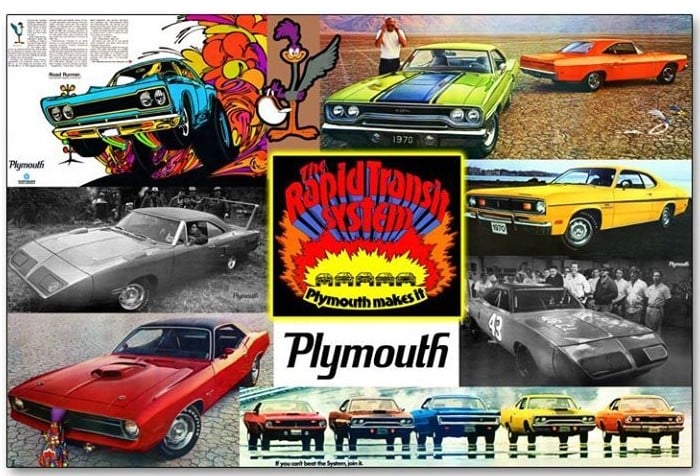Chrysler Corporation went through a crazy design period from the late-’60s to the early-’70s. At the time, many observers wondered if there was something besides lead in the water around Highland Park, Michigan. Starting with 1970 E-Bodies, the Duster/Demon, and the new intermediate cars in 1971, they became a palette for a psychedelic kaleidoscope of vivid paint colors and livery.

During that time, Chrysler brought us Mod Tops, Hemi power, and a slew of cartoon mascots like SuperBee, Road Runner, Demon, Duster, and Scamp. There were Scat Paks, Rapid Transit Systems, and advertising campaigns that depicted a Peter Max-esque world with big bellbottoms and big horsepower.

What’s more, the color pallet from these years might have been lifted from Goldie Hawn’s wardrobe from the TV series, “Laugh-In.” Paint names like Plum Crazy, Go Mango, and Lime Light are forever enshrined in automotive history. There was never a cooler time for Mopar and all Pentastar muscle machines from this era are cherished today.

Then, a dark cloud descended upon Chrysler. The Demon was renamed the Dart Sport, and by the mid-’70s, the Mopar portfolio was neutered by safety and emissions standards. By 1981, Chrysler was building bland, cookie-cutter K-cars. There has never been a more dowdy, depressing transformation in the history of the automobile.

David Pagel, from Stevens Point, Wisconsin, remembers the classic era of psychedelic Mopars well. His first car was a 1972 Dodge Demon, and although they parted ways years ago, the old Duster twin lingered in his mind. When his brother located a wrecked 1972 Duster on Craigslist in 2019, David decided to revisit his Mopar affliction and build the Plymouth sport coupe of his dreams. David tells Street Muscle, “There are nine members of my immediate family, and they all have Chevys. I’m the lone Mopar guy and kind of the black sheep of the flock.”
Pagel, a married car mechanic with two kids, handled most aspects of the build. Originally a black-on-black car with a white stripe, this Duster had been wrecked on the front corner and the unibody had sustained damage. The seller lost interest in any aspect of rebuilding the car, so David snapped it up. During the next four years, with help from brother Shawn, he skewered the old Mopar on a rotisserie, rebuilt it better than new, and christened it Twistd.

Per usual, there were pitfalls along the way. Not only did the car need to have its front subframe yanked back into alignment, but the car was infested with a bad case of the tinworm. The floors, fenders, and trunk required an exorcism and that gobbled up a good chunk of time. With the car pulled back true and straight with fresh sheetmetal, Pagel got to work renewing every aspect of the car, both cosmetically and mechanically.

He took a 1970 340 cubic-inch V8 to AMT Race Engines in Ferguson, Missouri, and the mill was bored, stroked, and buffed into a 422 cubic-inch, fire-breathing banshee with roughly 700 horsepower and 697 lb-ft of torque. All that grunt is fed to a built three-speed 727 Torquflite, transferring the power to a Mopar rearend with 4:11 gears and Mark Williams axle.

The car now rides on a QA1 front suspension complete with stout new K-member, control arms, and shocks from Competition Engineering. In the rear, Mopar subframe connectors, another pair of Competition Engineering shocks, Calvert Racing mono leaf springs provide a stout pathway for all that Mopar power.
Twistd, rolls on Billet Specialties Win Lite alloy rims, 26×4.5-inch up front and burly 29×11.5-inch out back. Pagel went with Hoosier tires, skinnies at the bow, and Pro Quick Times at the stern. Wilwood brakes all the way around, bring the party to a halt with sure, quick stops.

Now that the foundation was squared away, Pagel went work finishing up the unibody. He married a shark tooth grille from a 1971 Duster with the 1972-only wide taillights and aggregated the best styling features of the two years. From there, he added an AAR Fiberglass 6-pack hood, AAR Fiberglass bumpers, and aluminum bracketry. He called up the guys over at RSM Hydrographics and had them dip numerous components for a nice textural contrast as well.

At first blush, it might seem that Pagel went with one of Mopar’s famous FJ5 lime green hues from the High Impact color palette the company offered from 1969 to 1971. The wild shade of green was called SubLime if you bought a Dodge or Lime Light if you went with Plymouth.
Pagel had seen a car painted lime green at a car show and noticed there was always a big crowd around it, and that planted a seed in his head. He talked with the owner about relaying the mixology of the hue, but the guy would only give two parameters to Pagel because he wanted to make sure no one had the same color as his car.

Undeterred, Pagel and his brother spent days doing trial and error to concoct the shade of paint that Twistd wears today. Not only that, they tried several different base colors as a substrate, with a simple refrigerator white winning out. The final color, while very similar FJ5 Lime Light, packs more fluorescence and a smidgen more tartness than the stock Chrylser shade. Pagel relied on DuPont paints for Twistd.

Inside the cabin, it’s pretty simple and straightforward. The car has mostly original guts, with the exception of new door panels, carpet, and headliner. The column-mounted shifter and bench seat accurately reflect what most Dusters were at the time, an inexpensive commuter car. The “Tuff” steering wheel and AutoMeter gauges add a skosh of coolness to the otherwise old-school, plebeian interior.
For now, David is enjoying the car with future plans that include racing and tracking the car. Where ever he goes, Twistd will not only remind old-timers of one of the wildest design phases in automotive history but will educate younger fans of just how hip Chrysler was back in the day. We also wanted to thank the Pagel brothers for saving this old Duster. Wrecked, rusty old cars are almost always banished to the crusher, but miraculously, vintage muscle and the era of psychedelic Chrysler performance cars live on in the “Lime Light” with David Pagel’s Twistd.


About the author